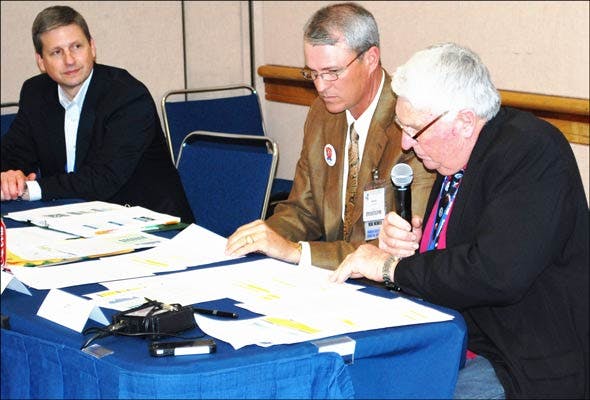Exports Hot Topic at Cattle Industry Annual Convention

USMEF Chairman Steve Isaf addresses the beef industry’s Joint Global Growth Committee
With the final results released today, U.S. beef export value set another record in 2012 — $5.51 billion – exceeding the $5.42 billion exported in 2011. Export momentum also received a recent boost when Japan agreed to raise the cattle age limit for imports of U.S. beef from 20 months to 30 months. Expanded access to Japan is projected to equate to an additional $20 per head of fed slaughter and move Japan back into its pre-BSE position as the leading value destination for U.S. beef.
“The impact of this change is immediate, and there is tremendous enthusiasm and support for it in Japan,” said USMEF President and CEO Philip Seng. “It’s really just a matter of how quickly the U.S. industry can ramp up its supply, because customers in Japan are enthusiastic and demand is definitely there.”
Even as producers cheer expanded access to Japan, however, they are frustrated by trade obstacles in other markets – including the likely closure of the Russian market on Feb. 11, due to the impasse over ractopamine.
“Russia is a significant setback, especially with the great success U.S. beef was achieving in that market,” Seng said. “We also continue to be frustrated by the market closure in Saudi Arabia (which closed in May 2012 due to the BSE case in California) and the lack of access to markets we’ve never re-entered after BSE – such as China and Australia.”
Seng explained that while Australia may never be a significant destination for U.S. beef, lack of access to the market sends the wrong signals to other trading partners and gives Australia a competitive advantage. In China, beef consumption has recently surged and other beef exporting countries are capitalizing while the United States is relegated to the sidelines.

Chairman Larry Pratt (right) and Vice Chairman Austin Brown III convene the meeting of the beef industry’s Joint Global Growth Committee. At far left is Greg Hanes, USMEF staff liaison to the committee.
At Thursday’s meeting of the beef industry’s newly restructured Global Growth Committee, cattle producers were asked to identify critical challenges facing U.S. beef in the international marketplace, as well as key advantages. Lack of a national traceability program was a popular choice in terms of challenges, along with the scarcity of financial resources for international promotions. In terms of advantages, producers identified the quality and consistency of U.S. beef along with the network of USMEF professionals representing it in overseas markets.
The committee was also addressed by USMEF Chairman Steve Isaf, founder and president of Interra International. As an exporter who conducts business in 85 foreign countries, Isaf provided his perspective on the challenging nature of global marketing and thanked committee members for the support they provide through the Beef Checkoff Program.
Isaf identified common ground with cattle producers when he explained the nature of Interra International’s business.
“As an exporter, I’m buying beef from the supplier and selling it in foreign countries,” Isaf said. “I purchase the product, I take complete risk, and just like everyone in this room I believe that everything I have in the world is on the line every day – just like you. So I want to thank you for producing a fine product that has allowed me to have a 33-year career in this industry.”
Committee meetings continued today, including a meeting of the policy-oriented NCBA Cattle Marketing and International Trade Committee. The convention concludes Saturday with meetings of the Cattlemen’s Beef Board and the NCBA board of directors.
